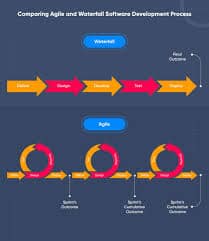Agile scrum methodology is an incremental development-based approach to project management. The purpose of each sprint, which lasts two to four weeks during each iteration, is to implement the most crucial features first and produce a potentially shippable item. Read below for more details on the scrum framework, agile scrum methodology, and its example.
What Is Agile Scrum Methodology
Agile scrum methodology is a sprint-based project administration approach with the objective of providing stakeholders with the greatest possible value. It’s interesting to note that the scrum approach is an agile framework that promotes efficiency and collaboration in software development and testing. Product delays, sprint delays, and sprint goals are the three components that make up a sprint in a scrum-based software project. A particular function is established, developed, and tested during each sprint. Each sprint spans between two and three weeks, depending on the project’s complexity. It is quicker and simpler to discover it in the sprint queue rather than having to restart every stage of software development, as with the waterfall technique, if any business demands a change that necessitates a code change.
The scrum master is accountable for ensuring each project’s success using this framework. He or she is responsible for making sure that everyone on the team stays on task, addressing and resolving any issues that may emerge, verifying that the project is using scrum practices, and enforcing deadlines. Teams often use an agile methodology, which is a cooperative and flexible approach, to complete tasks more quickly. The widely utilized method of project management is frequently a simpler method to keep interconnected teammates organized and on task. They work on a project through a series of iterations using agile, which are then prioritized based on feedback from customers.
Scrum Framework
The Scrum framework is a project management system that prioritizes collaboration, responsibility, and incremental advancement toward a clear objective. The framework starts with a straightforward directive: Begin with what is visible or understandable. After that, evaluate the results and make any necessary adjustments. Since the early 1990s, complicated product development has been handled by employing the scrum framework. Also, scrum is a framework through which other processes and techniques can be used, not a process or methodology for creating goods. Scrum makes it evident how effective your product management, as well as development processes, are in comparison, so you can make changes.
Scrum teams, along with the roles, events, objects, and rules they are connected with, make up the scrum framework. Each part of the framework has a specific function and is vital to the success and use of Scrum. The scrum framework directs product development, emphasizing value and high progress visibility. A scrum team creates the product from a concept by functioning from a dynamic list of the most important tasks, using the scrum architecture to promote transparency, inspection, and adaptation. Scrum aims to facilitate team collaboration so that teams can delight clients.
Scrum is a framework for processes that specifies certain guidelines, occasions, and responsibilities to establish regularity. However, assuming the fundamental scrum rules are followed, they may be modified to fit the demands of each business.
The scrum guidelines control the interactions and relationships between occurrences, responsibilities, and objects by connecting them all together. This tutorial includes explanations of the scrum rules.
Scrum Methodology Examples
Below are the scrum methodology examples:
#1. Applying Scrum to Human Resources (HR)
The authors of scrum for Dummies, Mark Layton and David Morrow, use the case of paraxial information systems, an American enterprise engaged in the biopharmaceutical industry, which had a sudden need to hire more than 20 people.
The lack of a hiring or onboarding staff to ease the integration of new employees into the company was one of the many difficulties the company encountered. The organization implemented this scrum methodology example. This carried out planning, created an agenda map, and started “week-long sprints” to track progress. Parexel hired, trained, and incorporated 21 new workers for the new project in under seven weeks. The team worked together to accomplish the goal, assessing the work’s progress and making adjustments as needed.
#2. Scrum used in Dutch Railways Software Project
This is another scrum methodology example. As detailed in this particular case study, a Dutch railway was in need of creating passenger travel information software. The automatic communication of times, locations, and intervals by sound should be displayed on displays.
A requirement of the client was to be allowed to watch the project progress over time, not just when the finished product was delivered. Utilizing this scrum methodology example proved it possible to deliver products incrementally, with higher customer involvement in every phase and improved oversight of all project teams.
#3. Scrum For Wedding Planning
In this particular scrum methodology example. scrum may be used to manage a wedding, among other events, and can help with time, money, and stress reduction. In this case, creating the wedding backlog entails making a list of all the components necessary to make the event successful, such as the photographer, the venue, the invites, the catering, etc.
The next stage would be to take precedence over the wedding backlog or arrange the components in order of importance. The newlyweds would consider how long it would require to finish each task when organizing the sprint. The couple is able to set up a schedule for their follow-up meetings. The retrospective also provides an opportunity to talk about the sprint and determine what areas could use improvement. Wedding plans are made easy when you use this scrum methodology example.
What Is the Difference Between Scrum and Agile?
These are the difference between scrum and agile
The primary distinction between agile and scrum is the reality that the former is an approach regarding how to provide software to a client, while the latter is a very effective methodology for doing so. Agile is a philosophy for software delivery to consumers, while scrum is a software development technique.
Scrum is an agile approach that aims to create business value as quickly as feasible, whereas agile is an ongoing cycle of testing and development. Software is regularly supplied for feedback under the agile technique, but under the scrum methodology, the product is released at the conclusion of each development sprint.
For good reason, scrum is an agile methodology. Agile and scrum use similar techniques like collaborative iterations. However, despite the fact that both entail project builds, they also have certain distinctions. Scrum is the best choice for people who need to generate results as soon as possible because it is a more strict approach with less room for adjustment. Agile is best for smaller teams and individuals that seek simpler design and implementation.
The simplest way to approach this is to think of scrum as always being agile but not always being agile. This means that while scrum will include the same agile methodology, agile might not possess all of the same characteristics as scrum.
What Are the 3 Roles in Scrum?
The scrum master, the product’s owner, and the members of the development team make up a scrum team. Below is a brief discussion about the three roles of the scrum.
#1. Scrum Master
A scrum team must follow the scrum values as closely as possible, and the scrum master is in charge of making sure this happens. This implies that they steer the team toward its goals, organize and conduct meetings, and resolve any challenges the group may encounter. Additionally, scrum masters may take on more responsibility inside an organization to assist in integrating scrum ideas into daily operations. They are frequently referred to as the “servant leader” of the scrum group because they are both a leader and a backroom helper.
The implementation of scrum differs from team to team and organization to organization, making the particular tasks of scrum masters vary. However, in general, a scrum master may be in charge of the following tasks:
- Organize daily standups, often known as scrum meetings.
- Organize sprint planning sessions.
- To determine what worked well and what needs to be changed for the next sprint, conduct “retrospective” reviews.
#2. The Manufacturer
A product owner ensures that the scrum team is working toward the same general goals. They are aware of the product’s business requirements, including market developments and client expectations. Product owners frequently communicate with product executives and other external stakeholders because they need to know how the scrum team integrates into larger objectives.
The following obligations may fall on the shoulders of the manufacturer:
- Order tasks to oversee the product backlog according to priority.
- Set the team’s product vision.
- Communicate with third parties and convey their desires to the group
- US annual salary average: $115,800
#3. The Advancement Team
The advancement team is made up of experts who carry out the practical work of finishing each task in a scrum sprint. As a result, members of the development team can do any necessary job to accomplish the sprint goals, including technicians, designers, writers, and data analysts. The advancement team typically works together to establish objectives and strategies for accomplishing them rather than passively waiting for orders. The ultimate objectives of the scrum team will also influence the duties of a development team. However, generally speaking, you might discover that the advancement team can be given the following tasks:
- Assistance with goal-setting and sprint planning.
- Contribute knowledge to product computing, design, or improvement.
- Utilize data to identify development best practices.
- Prototypes and test items, as well as other methods of quality control.
What Are the 4 Agile Methodology?
The agile manifesto lists these four fundamental methodologies as its foundation:
- Partnership with customer
- Responding to change
- People and interactions
- Working Software
#1. Partnership With Customers
The contract used to be the most crucial component of project development. With your customer, you would draft a thorough contract outlining all the specifics of the finished product. However, as you can expect, there was a significant discrepancy between what the developers produced, what the contract stated, and what the client truly required.
The emphasis should be on the ongoing improvement of your product rather than continuing to use this antiquated strategy. Because of this, it’s crucial to collaborate with your client to produce the best final product.
#2. Responding to Change
Similarly, with software development, not every modification will turn out to be beneficial. advantageous, but preserving the status quo doesn’t encourage advancement. You aren’t forced to step outside of your comfort zone. Customers will keep asking for modifications and adjustments until you produce the finished product they want. This is the major justification for the agile manifesto’s recommendation that software teams ought to remain able to modify the course of their work as needed.
#3. Working Software
Software programmers used to spend years documenting. Before writing any code. Even if documentation helps, teams should focus on the process and provide high-quality, functional software. Customer-centricity is stressed in this agile manifesto principle. After giving the client the finished product, expect corrections and use them to improve it.
#4. People and interactions
The great majority of software development teams formerly concentrated just on using the finest procedures and resources to create their program. The tech sector, though, is still evolving. The agile manifesto contends that while the technical aspects of the process are vital, the people who support it are more crucial. In this context, effective communication refers to the best software.
How Many Phases Are There in Scrum?
Teams can collaborate in an effective, structured manner using the scrum framework for agile project management. It is broken down into five distinct phases: initiation, planning, estimation, implementation, review, and release. Learn more about hiring talent for agile scrum teams.
Related Articles
- WHAT IS SCRUM: Definition, Principles, and Purpose
- AGILE PROJECT MANAGEMENT TOOLS: Definition, Uses, And List of APM
- PRODUCT BACKLOG: Definition, Examples, Management & Difference






